List of color palettes
This article is a list of the color palettes for notable computer graphics, terminals and video game console hardware.
Only a sample and the palette's name are given here. More specific articles are linked from the name of each palette, for the test charts, samples, simulated images, and further technical details (including references).
In the past, manufacturers have developed many different display systems in a competitive, non-collaborative basis (with a few exceptions, as the VESA consortium), creating many proprietary, non-standard different instances of display hardware. Often, as with early personal and home computers, a given machine employed its unique display subsystem, with its also unique color palette. Also, software developers had made use of the color abilities of distinct display systems in many different ways. The result is that there is no single common standard nomenclature or classification taxonomy which can encompass every computer color palette.
In order to organize the material, color palettes have been grouped following arbitrary but rational criteria. First, generic monochrome and full RGB repertories common to various computer display systems. Second, usual color repertories used for display systems that employ indexed color techniques. And finally, specific manufacturers' color palettes implemented in many representative early personal computers and videogame consoles of various brands.
The list for personal computer palettes is split into two categories: 8-bit and 16-bit machines. This is not intended as a true strict categorization of such machines, because mixed architectures also exist (16-bit processors with an 8-bit data bus or 32-bit processors with a 16-bit data bus, among others). The distinction is based more on broad 8-bit and 16-bit computer ages or generations (around 1975–1985 and 1985–1995, respectively) and their associated state of the art in color display capabilities.
Here is the common color test chart and sample image used to render every palette in this series of articles:
See further details in the summary paragraph of the corresponding article.
List of monochrome and RGB palettes
For the purpose of this article, the term monochrome palette means a set of intensities for a monochrome display, and the term RGB palette is defined as the complete set of combinations a given RGB display can offer by mixing all the possible intensities of the red, green, and blue primaries available in its hardware.
These are generic complete repertories of colors to produce black and white and RGB color pictures by the display hardware, not necessarily the total number of such colors that can be simultaneously displayed in a given text or graphic mode of any machine. RGB is the most common method to produce colors for displays; so these complete RGB color repertories have every possible combination of R-G-B triplets within any given maximum number of levels per component.
For specific hardware and different methods to produce colors than RGB, see the List of computer hardware palettes and the List of videogame consoles sections.
For various software arrangements and sorts of colors, including other possible full RGB arrangements within 8-bit depth displays, see the List of software palettes section.
Monochrome palettes
- These palettes only have some shades of gray.

Monochrome (1-bit)
black and white
Monochrome (1-bit) black and white, with Floyd-Steinberg dithering 
2-bit grayscale
22 = 4 levels of gray
2-bit grayscale, with Floyd-Steinberg dithering 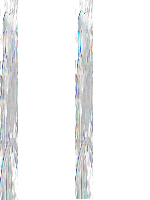
4-bit grayscale
24 = 16 levels of gray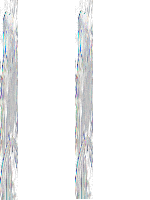
4-bit grayscale, with Floyd-Steinberg dithering 
8-bit grayscale
28 = 256 levels of gray
Regular RGB palettes
- These full RGB palettes employ the same number of bits to store the relative intensity for the red, green and blue components of every image's pixel color. Thus, they have the same number of levels per channel and the total number of possible colors is always the cube of a power of two. It should be understood that 'when developed' many of these formats were directly related to the size of some host computers 'natural word length' in bytes—the amount of memory in bits held by a single memory address such that the CPU can grab or put it in one operation.

3-bit RGB
23 = 8 colors
• More than the four colors available with the CGA video standard used ca. 1981-84.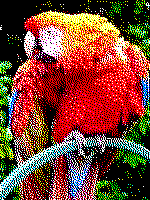
3-bit RGB, with Floyd-Steinberg dithering 
6-bit RGB
43 = 64 colors
9-bit RGB
83 = 512 colors
12-bit RGB
163 = 4096 colors
15-bit RGB
323 = 32,768 colors (HighColor)
18-bit RGB
643 = 262,144 colors
24-bit RGB
2563 = 16,777,216 colors (TrueColor)
• Often referred to as 'RGB24'. Further:
Adding another 8-bit grayscale channel 'AlphMask or 'Alpha channel' creates 'RGB32' and gives shading capabilities as are commonly used in .tga and .png file formats.
Non-regular RGB palettes
- These are also RGB palettes, in the sense defined above (except for the 4-bit RGBI, which has an intensity bit that affects all channels at once), but either they do not have the same number of levels for each primary channel, or the numbers are not powers of two, so are not represented as separate bit fields. All of these have been used in popular personal computers.

4-bit RGBI
23×2 = 16 colors
3-level RGB
33 = 27 colors
3-3-2 bit RGB
8×8×4 = 256 colors
16-bit RGB
32×64×32 = 65,536 colors (HighColor)
List of software palettes
Systems that use a 4-bit or 8-bit pixel depth can display up to 16 or 256 colors simultaneously. Many personal computers in the later 1980s and early 1990s displayed at most 256 different colors, freely selected by software (either by the user or by a program) from their wider hardware's color palette.
Usual selections of colors in limited subsets (generally 16 or 256) of the full palette includes some RGB level arrangements commonly used with the 8 bpp palettes as master palettes or universal palettes (i.e., palettes for multipurpose uses).
These are some representative software palettes, but any selection can be made in such types of systems.
System specifics
- These are selections of colors officially employed as system palettes in some popular operating systems for personal computers that feature 8-bit displays.

Microsoft Windows default 16-color palette
16 colors
Microsoft Windows default 20-color palette
20 colors
Apple Macintosh default 16-color palette
16 colors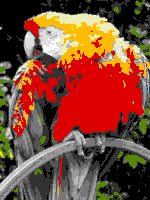
RISC OS default 16-color palette
16 colors
RGB arrangements
- These are selections of colors based on evenly ordered RGB levels, mainly used as master palettes to display any kind of image within the limitations of the 8-bit pixel depth.

6 level RGB
63 = 216 colors
6-7-6 levels RGB
6×7×6 = 252 colors
6-8-5 levels RGB
6×8×5 = 240 colors
8-8-4 levels RGB
8×8×4 = 256 colors
Other common uses of software palettes

Grayscale palettes
up to 256 levels of gray_palette_sample_image.png)
Color gradient palettes
up to 256 levels of any arbitrary hue
Adaptive palettes
up to 256 picked colors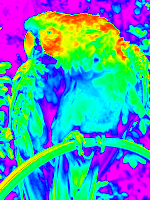
False color palettes
up to 256 continuous-tone colors
List of computer hardware palettes
In early personal computers and terminals that offered color displays, some color palettes were chosen algorithmically to provide the most diverse set of colors for a given palette size, and others were chosen to assure the availability of certain colors. In many early home computers, especially when the palette choices were determined at the hardware level by resistor combinations, the palette was determined by the manufacturer.
Many of early models output composite video YPbPr colors. When seen on TV devices, the perception of the colors may not correspond with the value levels for the YPbPr values employed (most noticeable with NTSC TV color system).
For current RGB display systems for PC's (Super VGA, etc.), see the 16-bit RGB and 24-bit RGB for HighColor (thousands) and TrueColor (millions of colors) modes.
For video game consoles, see the List of videogame consoles section.
For every model, their main different graphical color modes are listed based exclusively in the way they handle colors on screen, not all their different screen modes.
The list is ordered roughly historically by video hardware, not grouped by branch. They are listed according to the original model of every system, which implies that enhanced versions, clones and compatibles also support the original palette.
Terminals and 8-bit machines

Teletext (1976)
2x3 pixel Graphic block characters (on 40x25 grid with some reserved areas = 78x69 overall resolution) with 2 colors per block, chosen from 80 000 000 primary colors.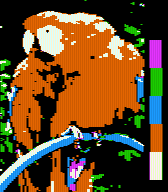
Apple II (1977)
"Low" (text block) 16 color, "high resolution" (140x192 bitmap) 4 color and "double high" 6 color (NTSC artefact based; actually 280x192 monochrome) graphic modes.
Commodore VIC-20 (1981)
200 definable characters of 8×16 pixels each, 8 or 10 color palette modes with 2 colors per character cell.
CGA for IBM-PC (1981)
16 color text mode (unofficially adjustable to give a 160x100 16 color bitmap mode), 4 color medium and monochrome high resolution graphic modes; medium resolution modes select from six preset palettes (four official, two undocumented; actually three main palettes in low and high intensity form) for the three "foreground" colors, with a free choice amongst the 8 low intensity colors for the fourth, "background" color. All modes work within the same 16 color master palette as text mode.
Commodore 64 (1982)
Low-resolution "Multicolor" (4 colors per sprite or character cell) and medium resolution (2 color per sprite/cell) graphic modes, choosing from 16 color master palette.
ZX Spectrum (1982)
Bitmapped display with 15 colors (primary hues with two intensity levels for each except black), assigned on the basis of two "attributes" per 8x8 pixel character cell. Cells also share one intensity level between both "paper" and "ink" colors.Mattel Aquarius (1983)
- Similar character block and "pixel" arrangement to Teletext, but resolution is a true 80x72 (2x3 pixels on 40x24 grid) and master palette is expanded to 16 colors.
MSX systems (1983)
"Screen 2" and "Screen 3" 15-color graphic modes.
Thomson MO5 (1984)
- Fixed 16-color palette, with 2 colors per block on a 8x1 pixel attribute grid.
Commodore Plus/4 (1984)
Multicolor and High resolution 16 color graphic modes, from 128 color master palette.
Amstrad CPC (1984)
Low 16-, medium 4- and high resolution 2-color graphic modes (160, 320 and 640 x 200 pixel), from 27 color master palette (3 levels for each of red, green and blue).
MSX2 systems (1985)
"Screen 8" 256-color graphic modes
Fujitsu FM-77 AV 40 (1986)
Low 262,144-color and high resolution 8-color graphic modes, from 262,144 palette.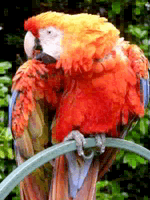
MSX2+ systems (1988)
"Screen 10&11" 12,499- YJK+YAE and "Screen 12" 19,268-color YJK graphic modes
16-bit machines

EGA for IBM-AT (1984)
Medium and high resolution 16-color graphic modes, out of 64.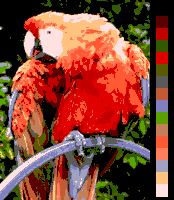
Atari ST (1985)
Low 16-, medium 4-color and high resolution monochrome modes, out of 512 (4096 on STe).
Commodore Amiga OCS (1985)
2-, 4-, 8-, 16- and 32-color standard graphic modes, EHB 64- and HAM 4096-color enhanced modes; 2 to 64 color modes pick from a 4096 color master palette, with 64 color mode constructed from 32 normally chosen colors plus a second set of 32 fixed at half the intensity of the first. HAM mode restricted by only being able to change one color channel (Red, Green or Blue) per pixel.
Apple IIgs (1986)
Super High Res 4-, 8-, 16- and 256-color graphic modes, from 4096, with some palette choice restrictions in 80-column modes.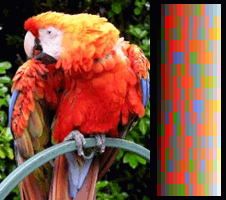
MCGA and VGA for IBM-AT (1987)
Medium 256- and high resolution 16-color graphic modes, from 262,144.
Sharp X68000 (1987)
Medium 65,536-color and high resolution 16-color graphic modes, from 65,536.
List of video game console palettes
Color palettes of some of the most popular videogame consoles. The criteria are the same as those of the List of computer hardware palettes section.

Atari 2600 (1977)
4 out of 128 colors on every scanline
Famicom/NES (1983)
25 out of 54 usable colors (within a non-uniform 64-color logical palette); 1x Background color, 4x 3-color (plus transparent) tile palettes and 4x 3-color (plus transparent) sprite palettes.
Sega Master System (1985)
32 colors out of 64
NEC PC-Engine/TurboGrafx-16 (1987)
482 colors out of 512
Sega Mega Drive/Genesis (1988)
61 colors out of 512 (or approximately 1500 including shadow/highlight modes)
Nintendo Game Boy (1989)
4 grayscales, rendered as shades of green on the original model's screen (and later, true grayscales, on the GameBoy Pocket).
Sega Game Gear (1990)
32 colors out of 4,096
Super Famicom/SNES (1990)
256 out of 32,768 colors
Nintendo Game Boy Color (1998)
Type 1 (original GameBoy) cartridges with free choice of various 10-color palettes (built into console and chosen at system start; no example shown), and Type 3 (GBC enhanced or exclusive) cartridges with own 56-color palettes. Arranged as a single background layer with 4 colors and 2 sprite layers of 3 colors plus transparent (Type 1), or 8 x 4-color background palettes with 8 x 3-color sprite layers (Type 3), chosen from a 32,768-color master palette.
Nintendo Game Boy Advance/SP/Micro (2001)
Type 1 (original GameBoy), Type 3 (GameBoy Color) 56-color and Type 4 (GBA) 32,768-color cartridges (limited to 512 simultaneous colors on-screen in some display modes)
